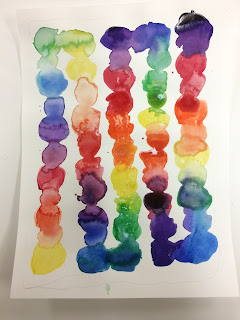My good friend Karen finally shared her award winning lesson with me.
It is a wonderful exploration into
non-Objective watercolor painting based on color theory.
I had to refresh my vocabulary while presenting this to my amazing 4th graders last week.
We explored the world of Tertiary or Intermediate colors.
Here are the basic supplies
fine point sharpie,
prang paints
90 lb cold press
watercolor paper,
and a color wheel.
fine point sharpie,
prang paints
90 lb cold press
watercolor paper,
and a color wheel.
I review with my students the primary and secondary colors with part of this video.
We have so many new ELL student's and this was a great tutorial.
After setting our table to paint, the students painted a ribbon color wheel.
We started with yellow, leaving a space a painting another amorphic shape of the secondary color orange. Using a wet brush they pulled the colors together to make the Tertiary color shape.
We used small color wheels to progress around the wheel and painting a large snake or ribbon.
When they finished in one class period they could add a little salt or rubbing alcohol.
(I heard a few requests for alcohol at the end of the lesson, yikes)
Today, on the second day of the lesson, we discussed Mapping. I shared my love of Maps.
I took Map Study in College and it took me to a different place other than just reading a paper map. (yes, I am old)
We discussed contour elevation maps.
Google it and you will see how maps are created with contour lines.
The student's then looked closely at their watercolor paintings and starting drawing amorphic contour lines around the various colors that were created in the previous class with a fine tip sharpie.
It was hard to slow down and just concentrate,
but with a little spa music in the
background they did it.
They were so pleased with the outcome too, which made me beam!
This guy had a lot of brown that he was unhappy with, but it worked.
Thank you so much Karen, for sharing and a big shout out to Holly for the
origional lesson inspiration with her art work.













You need a prize for always commenting. Thanks so much!
ReplyDeleteLove times a thousand.
ReplyDeleteThank you!
DeleteA great idea ! Really beautiful creations ! Thanks for sharing!
ReplyDeleteThank you for the positive comment!
DeleteWhat a fantastic art AND geography lesson! I LOVE it! Thank you for sharing this wonderful lesson!
ReplyDeleteyou are welcome
DeleteWhen I saw that first picture on pinterest I just had to drop by and see what it was. What a neat idea! Thanks for the inspiration today!
ReplyDeleteIt has been quite popular. Thanks
DeleteThis was a great video! The kids really enjoyed it coming from a "real " artist. thanks for sharing!
ReplyDeleteThe kids really enjoyed this video made by a "real artist"! Thanks for sharing. Great site.
ReplyDeleteThis is a terrific lesson! Thank you!
ReplyDeleteThis is wonderful. I'm now addicted to this!! Thanks so much!!!
ReplyDelete